Social and Infrastructural Conditioning of Lowering Energy Costs and Improving the Energy Efficiency of Buildings in the Context of the Local Energy Policy
Abstract
1. Introduction
1.1. Fuel Poverty in Poland
- Social policy: housing, energy, targeted benefits, electricity allowance, and installation of prepaid counters.
- Indirectly influence fuel poverty through changes in attitudes and awareness: a nationwide advisory support system for the public sector, housing and companies in terms of energy efficiency and renewable energy sources, promotion and energy efficiency education programs [5].
1.2. Increasing Energy Efficiency
1.3. Planning Research
2. Results
- Economic and cognitive factors: knowledge about the upgrading cost, potential energy savings, and the time at which the expenditure will be returned;
- Ecological awareness: knowledge of the importance of modernization for the environment;
- Demographic factors: age of residents, education;
- Economic factors: the level of income per person in the household and an assessment of the financial situation; and
- Psychological factors: the general willingness (or its lack) to make changes (Figure 2).
3. Discussion
4. Research and Methods
4.1. Research Date
4.1.1. Town Energy Audit for Zielona Góra
4.1.2. Questionnaire Surveys with Representatives of Households in Zielona Góra
- Occupied property (type and age of the building, rights to the property, area, number of residents, type and date of making a thermal insulation, window for thermal insulation, kind of heating);
- Importance of the environmental pollution issues in the local scale, that is, readiness to incur increased costs in case of the use of RES;
- Willingness for changes and investments in order to increase energy and heat savings; and
- Assessment of the financial situation made by respondents themselves.
4.2. Neural Networks as a Modeling Tool
4.3. Direction for Future Research
5. Conclusions
Author Contributions
Funding
Conflicts of Interest
References
- Owczarek, D.; Miazga, A. Ubóstwo Energetyczne w Polsce-Definicja i Charakterystyka Społeczna Grupy; Instytut na Rzecz Ekorozwoju: Warszawa, Poland, 2015. [Google Scholar]
- Lis, M.; Miazga, A.; Sałach, K. Zróżnicowanie Regionalne Ubóstwa Energetycznego w Polsce; Instytut Badań Strukturalnych: Warszawa, Poland, 2016. [Google Scholar]
- Thomson, H.; Snell, C.; Bouzarovski, S. Health, Well-Being and Energy Poverty in Europe: A Comparative Study of 32 European Countries. Int. J. Environ. Res. Public Health 2017, 14, 584. [Google Scholar] [CrossRef] [PubMed]
- Kazak, J.; Świąder, M. SOLIS-A Novel Decision Support Tool for the Assessment of Solar Radiation in ArcGIS. Energies 2018, 11, 1–12. [Google Scholar] [CrossRef]
- Szpor, A.; Lis, M. Ograniczenie Ubóstwa Energetycznego w Polsce–Od Teorii do Praktyki; Instytut Badań Strukturalnych: Warszawa, Poland, 2016. [Google Scholar]
- Stępniak, A.; Tomaszewska, A. Ubóstwo Energetyczne a Efektywność Energetyczna-Analiza Problemu i Rekomendacje; Instytut na Rzecz Ekorozwoju: Warszawa, Poland, 2013; pp. 20–23. [Google Scholar]
- Fabbri, K. Building and fuel poverty, an index to measure fuel poverty: An Italian case study. Energy 2015, 89, 244–258. [Google Scholar] [CrossRef]
- Kazak, J. The Use of a Decision Support System for Sustainable Urbanization and Thermal Comfort in Adaptation to Climate Change Actions—The Case of the Wrocław Larger Urban Zone (Poland). Sustainability 2018, 10, 1083. [Google Scholar] [CrossRef]
- Asadi, E.; Da Silva, M.; Antunes, C.; Dias, L. A multi-objective optimization model for building retrofit strategies using TRNSYS simulations, GenOpt and MATLAB. Build. Environ. 2012, 56, 370–378. [Google Scholar] [CrossRef]
- Teller-Elsberg, J.; Sovacool, B.; Smith, T.; Laine, E. Fuel poverty, excess winter deaths, and energy costs in Vermont: Burdensome for whom? Energy Policy 2016, 90, 81–91. [Google Scholar] [CrossRef]
- Lambert, J.G.; Hall, C.A.S.; Balogh, S.; Gupta, A.; Arnold, M. Energy, EROI and quality of life. Energy Policy 2014, 64, 153–167. [Google Scholar] [CrossRef]
- Sovacool, B. Fuel poverty, affordability, and energy justice in England: Policy insights from the Warm Front Program. Energy 2015, 93, 361–371. [Google Scholar] [CrossRef]
- Asadi, E.; da Silva, M.; Antunes, C.; Dias, L.; Glicksman, L. Multi-objective optimization for building retrofit: A model usinggenetic algorithm and artificial neural network and an application. Energy Build. 2014, 81, 444–456. [Google Scholar] [CrossRef]
- Webb, J.; Hawkey, D.; Tingey, M. Governing cities for sustainable energy: The UK case. Cities 2016, 54, 28–35. [Google Scholar] [CrossRef]
- Gorbacheva, N.; Sovacool, B. Pain without gain? Reviewing the risks and rewards of investing in Russian coal-fired electricity. Appl. Energy 2015, 154, 970–986. [Google Scholar] [CrossRef]
- Ringel, M.; Schlomann, B.; Krail, M.; Rohde, C. Towards a green economy in Germany? The role of energy efficiency policies. Appl. Energy 2016, 179, 1293–1303. [Google Scholar] [CrossRef]
- Gero, J.S.; Dcruz, N.; Radford, A.D. Energy in context—A multicriteria model for building design. Build. Environ. 1983, 18, 99–107. [Google Scholar] [CrossRef]
- Touloupaki, E.; Theodosiou, T. Optimization of Building form to Minimize Energy Consumption through Parametric Modelling. Procedia Envirn. Sci. 2017, 38, 509–514. [Google Scholar] [CrossRef]
- Flourentzou, F.; Roulet, C.A. Elaboration of retrofit scenarios. Energy Build. 2002, 34, 185–192. [Google Scholar] [CrossRef]
- Jaggs, M.; Palmer, J. Energy performance indoor environmental quality retrofit—A European diagnosis and decision making method for building refur-bishment. Energy Build. 2000, 31, 97–101. [Google Scholar] [CrossRef]
- CBOS. Polacy o Przyszłości Energetycznej Kraju; CBOS: Warszawa, Poland, 2016. [Google Scholar]
- CBOS. Ekologia w Energetyce–Deklaracje i Postawy; CBOS: Warszawa, Poland, 2016. [Google Scholar]
- CBOS. Polacy o Oszczędzaniu Energii i Energetyce Obywatelskiej; CBOS: Warszawa, Poland, 2016. [Google Scholar]
- Skiba, M. Energetyczny Audyt Miejski. Miejskie Systemy Predykcji Zużycia Energii. Available online: http://yadda.icm.edu.pl/yadda/element/bwmeta1.element.baztech-article-BTB2-0077-0089/c/Sobierajewicz_Energetyczny_12_2011.pdf (accessed on 31 August 2018).
- Kuczyński, T. Innowacyjność Podejmowanych Działań w Obszarze Odnawialnych źródeł Energii; Uniwersytet Zielonogórski, Wydział Inżynierii Lądowej i Środowiska: Zielona Góra, Poland, 2008. [Google Scholar]
- Staszczuk, A.; Wojciech, M.; Kuczyński, T. The effect of floor insulation on indoor air temperature and energy consumption of residential buildings in moderate climates. Energy 2017, 138, 139–146. [Google Scholar] [CrossRef]
- Miu, L.M.; Wisniewska, N.; Mazur, C.; Hardy, J.; Hawkes, A. A Simple Assessment of Housing Retrofit Policies for the UK: What Should Succeed the Energy Company Obligation? Energies 2018, 11, 2070. [Google Scholar] [CrossRef]
- Bazan-Krzywoszańska, A.; Skiba, M.; Mrówczyńska, M.; Sztubecka, M.; Bazuń, D.; Kwiatkowski, M. Green energy in municipal planning documents. E3S Web Conf. 2018, 45, 8. [Google Scholar] [CrossRef]
- Mrówczyńska, M. Studium Nad Doborem Metod Inteligencji Numerycznej Do Rozwiązywania Problemów z Geodezji Inżynieryjnej; Oficyna Wydaw Uniwersytetu Zielonogórskiego: Zielona Góra, Poland, 2015; ISBN 9788378421580. [Google Scholar]
- Skiba, M.; Mrówczyńska, M.; Bazan-Krzywoszańska, A. Modeling the economic dependence between town development policy and increasing energy effectiveness with neural networks. Case study: The town of Zielona Góra. Appl. Energy 2017, 188, 356–366. [Google Scholar] [CrossRef]
- Ascione, F.; Bianco, N.; De Stasio, C.; Mauro, G.; Vanoli, G. Artificial neural networks to predict energy performance and retrofit scenarios for any member of a building category: A novel approach. Energy 2017, 118, 999–1017. [Google Scholar] [CrossRef]
- Kumar, R.; Aggarwal, R.; Sharma, J. Energy analysis of a building using artificial neural network: A review. Energy Build. 2013, 65, 352–358. [Google Scholar] [CrossRef]
- Juszczyk, M.; Leśniak, A.; Zima, K. ANN Based Approach for Estimation of Construction Costs of Sports Fields. Complexity 2018, 7952434. [Google Scholar] [CrossRef]
- Beccali, M.; Ciulla, G.; Brano, V.; Galatioto, A.; Bonomolo, M. Artificial neural network decision support tool for assessment of the energy performance and the refurbishment actions for the non-residential building stock in Southern Italy. Energy 2017, 137, 1201–1218. [Google Scholar] [CrossRef]
- Nałęcz, M. Sieci Neurnowe; Akademicka Oficyna Wydawnicza: Warszawa, Poland, 2016. [Google Scholar]
- Lis, M.; Sałach, K.; Święcicka, K. Rozmaitość Przyczyn i Przejawów Ubóstwa Energetycznego; Instytut Badań Strukturalnych: Warszawa, Poland, 2016. [Google Scholar]
- Szpor, A. Ubóstwo Energetyczne w Polsce–Temat Zastępczy Czy Realny Problem? Instytut Badań Strukturalnych: Warszawa, Poland, 2016. [Google Scholar]
- Żurawski, J. Jakość energetyczna a wartość rynkowa nieruchomości. Izolacje 2011, 1, 22–26. [Google Scholar]
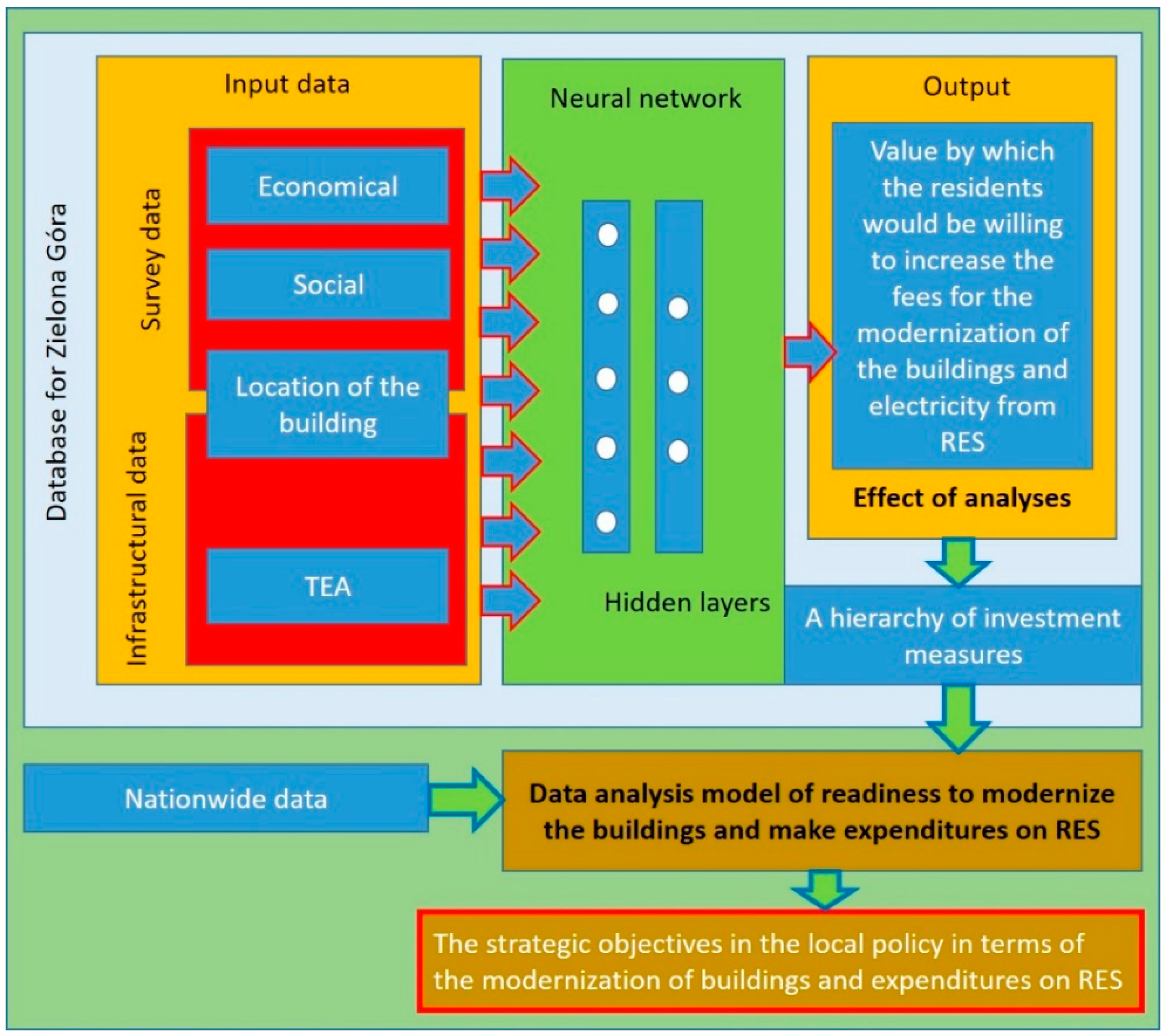
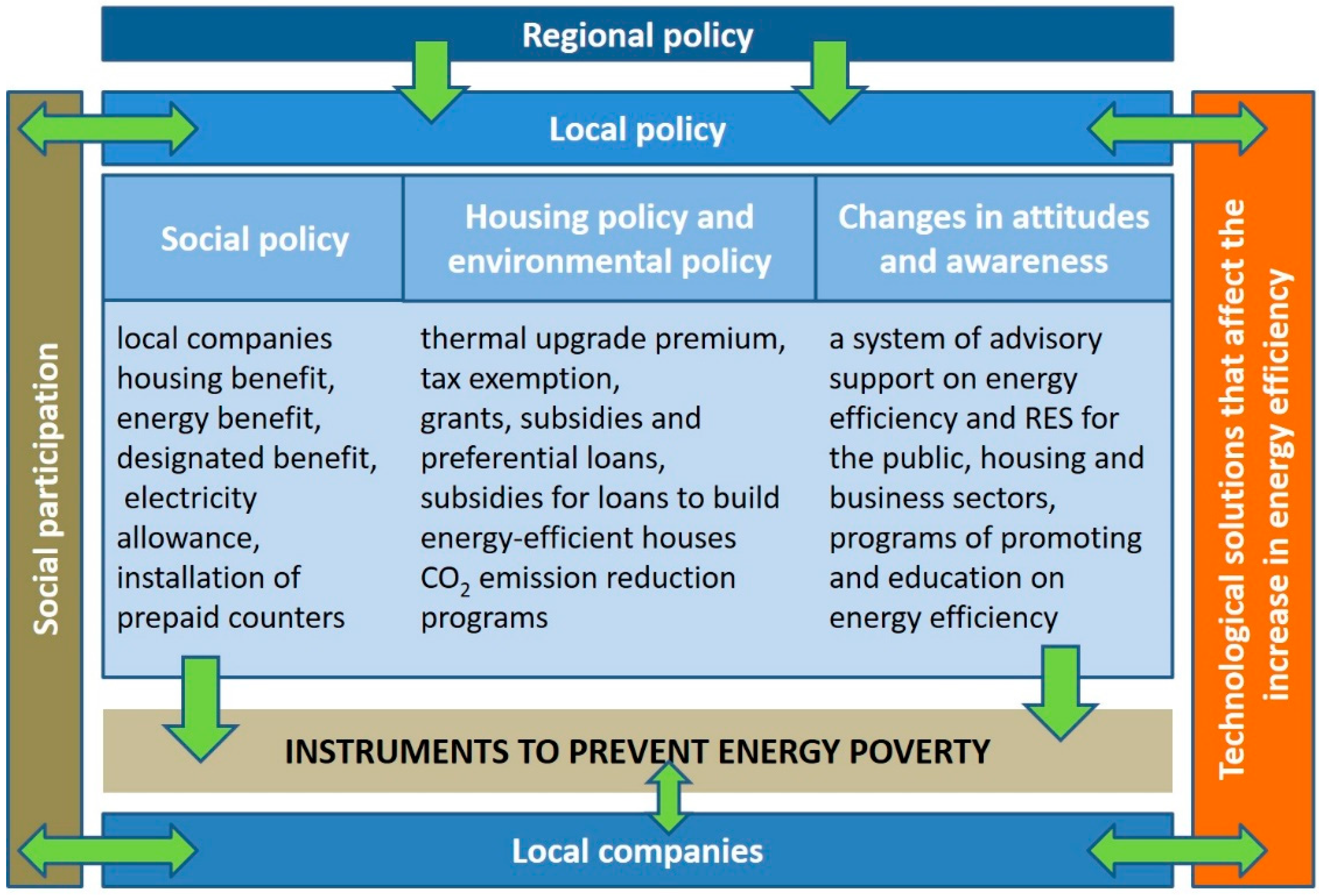

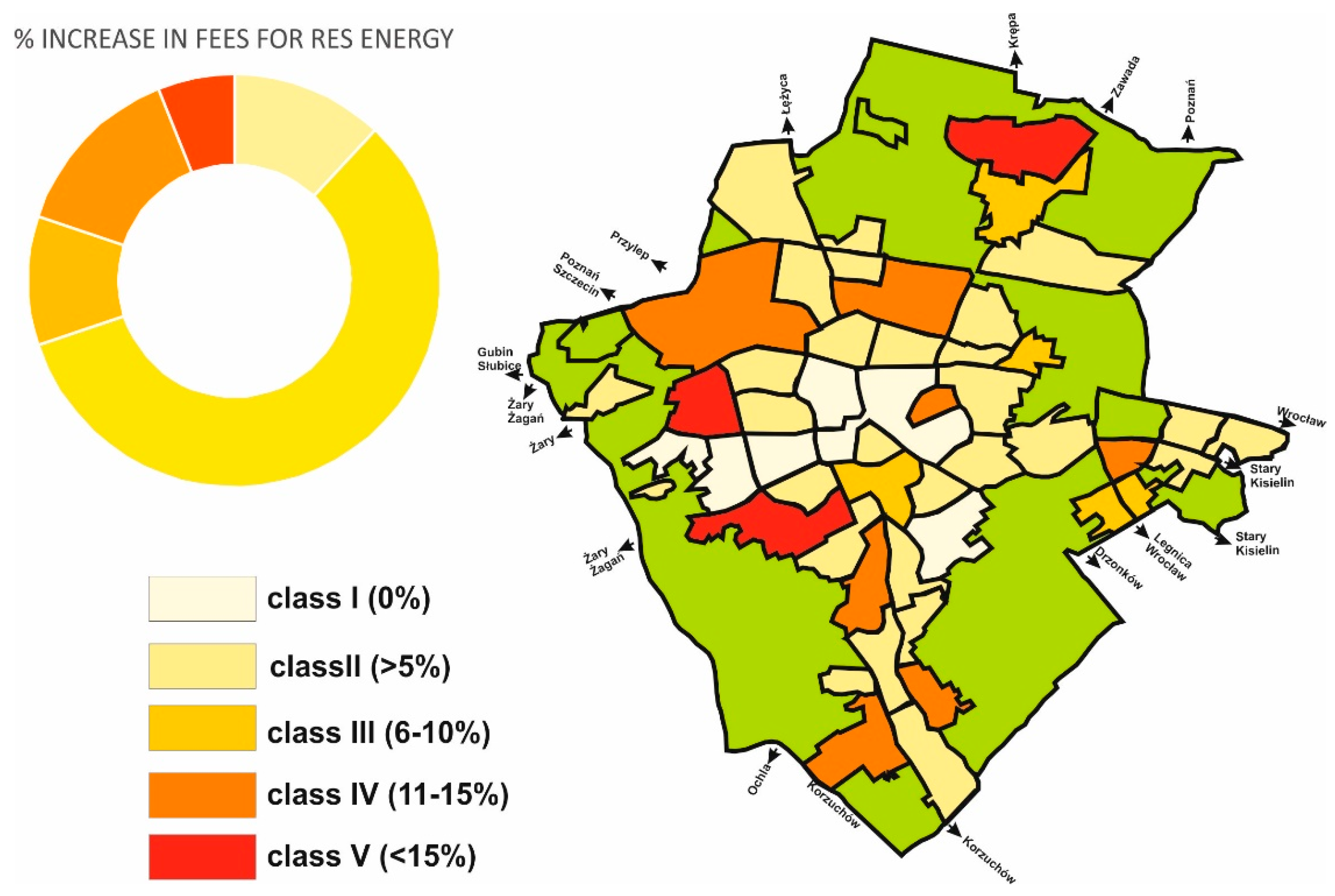
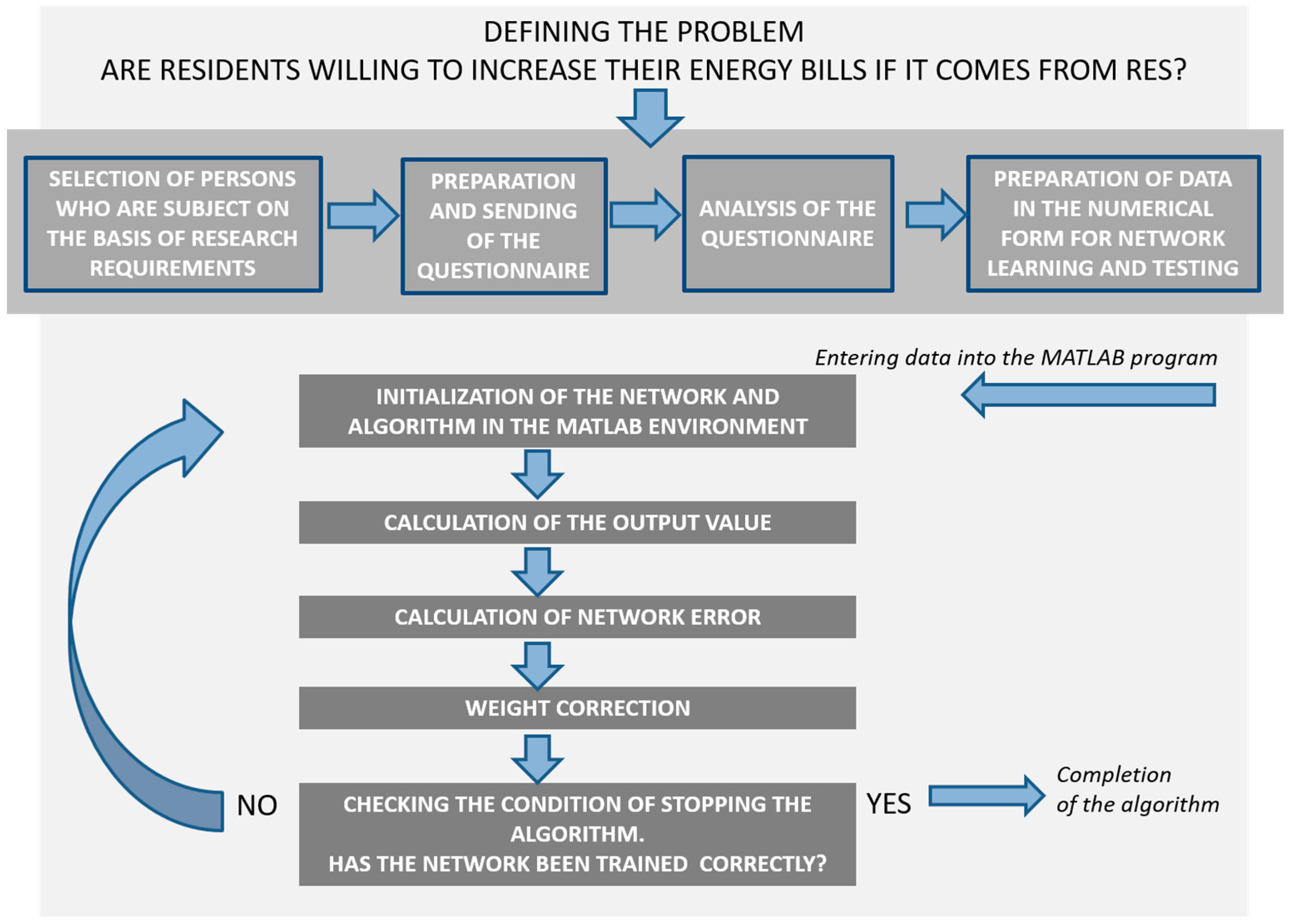
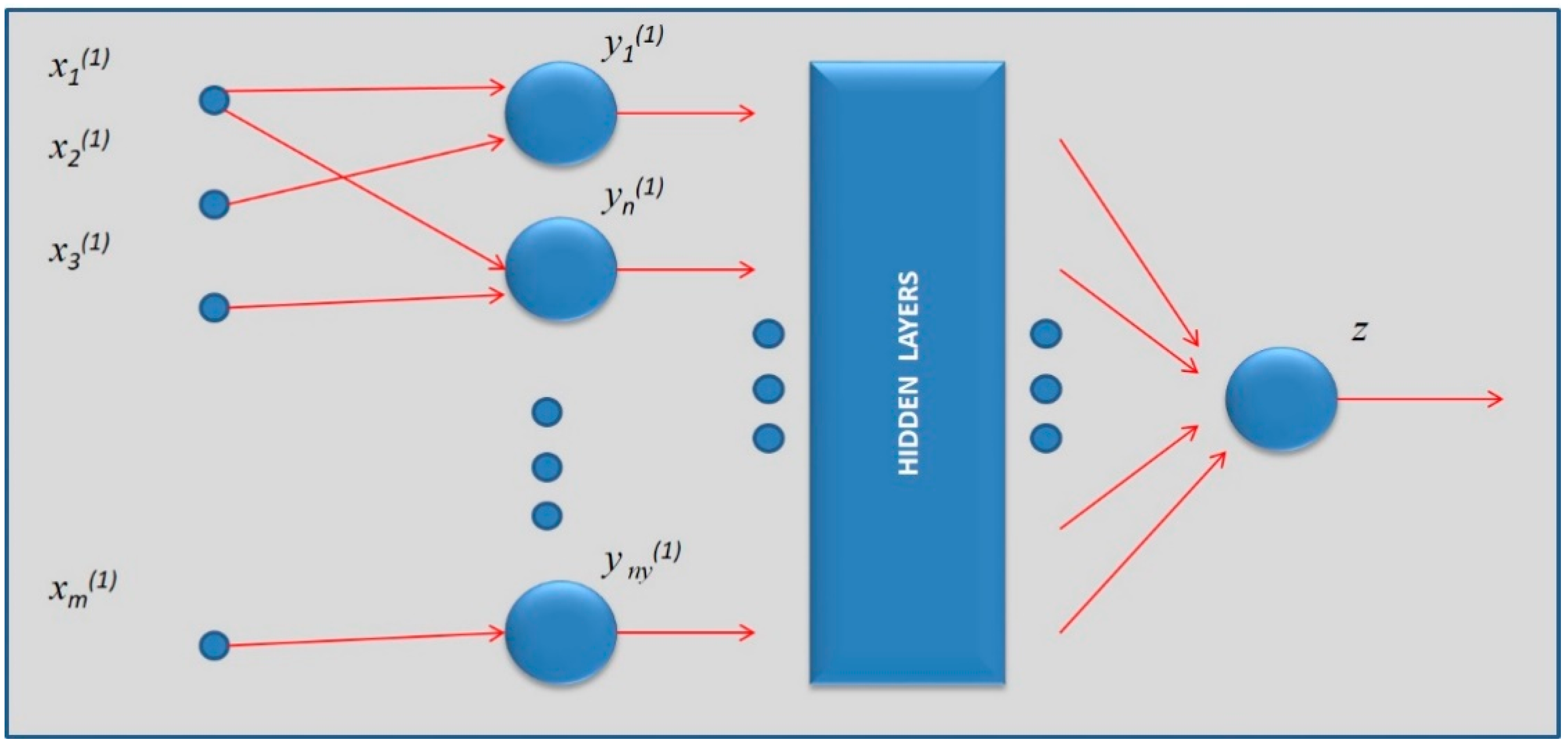
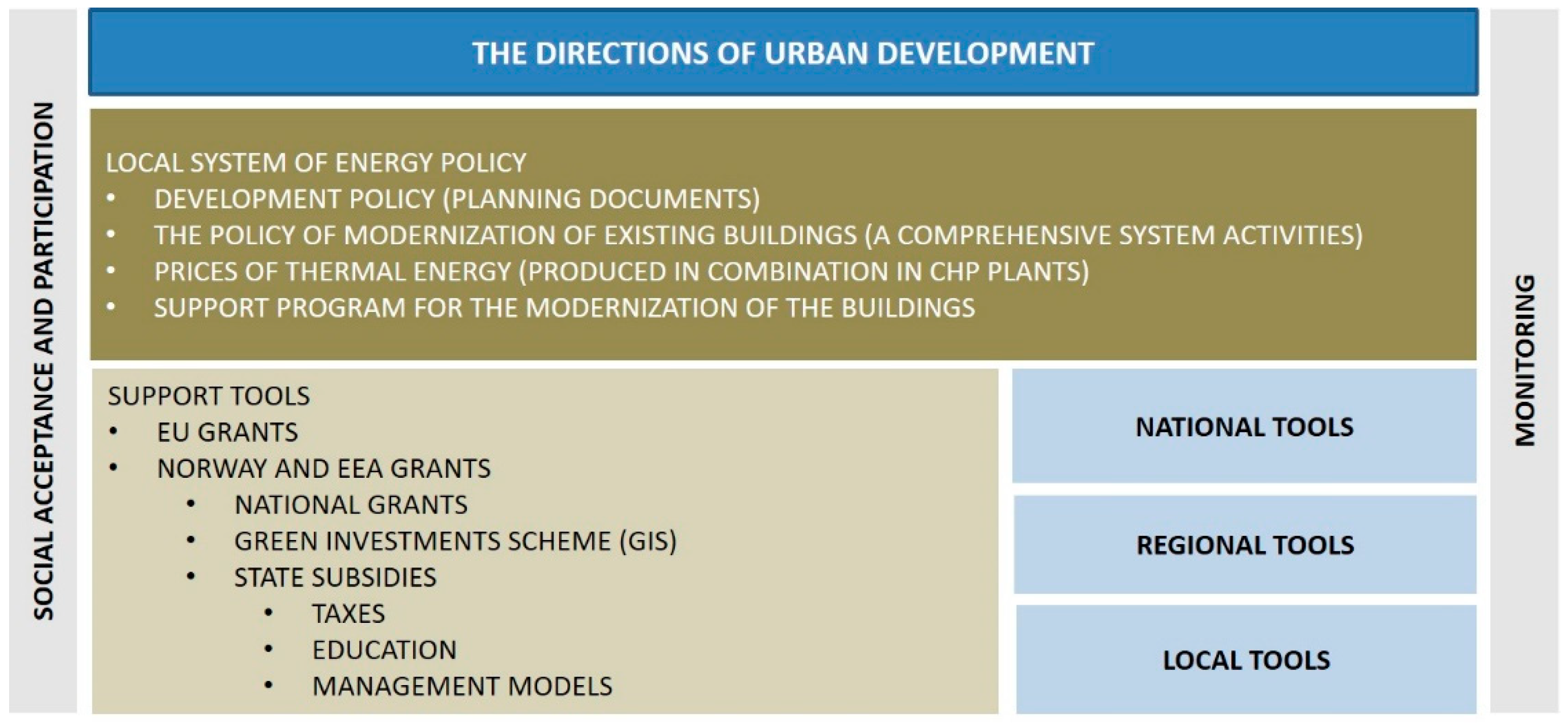
| Network Architecture | Bipolar Function | Unipolar Function | Sigmoidal Shape Function | |||
|---|---|---|---|---|---|---|
| Training Set | Testing Set | Training Set | Testing Set | Training Set | Testing Set | |
| Steepest Descent Method | ||||||
| 7_2_2_1 | 3.34% | 3.58% | 3.32% | 3.51% | 3.36% | 3.45% |
| 7_3_3_1 | 2.09% | 2.11% | 2.10% | 2.15% | 2.24% | 2.56% |
| 7_4_3_1 | 1.96% | 2.03% | 2.01% | 2.03% | 2.12% | 2.25% |
| 7_5_3_1 | 1.89% | 2.01% | 1.95% | 2.25% | 1.91% | 2.00% |
| 7_5_5_1 | 1.32% | 2.33% | 1.45% | 2.32% | 1.79% | 2.58% |
| Variable Metrics Method | ||||||
| 7_2_2_1 | 1.38% | 1.52% | 1.37% | 1.54% | 1.46% | 1.87% |
| 7_3_3_1 | 1.22% | 1.31% | 1.24% | 1.32% | 1.36% | 1.45% |
| 7_4_3_1 | 1.01% | 1.12% | 0.99% | 1.07% | 1.12% | 1.33% |
| 7_5_3_1 | 0.85% | 0.94% | 0.86% | 0.92% | 0.94% | 1.02% |
| 7_5_5_1 | 0.75% | 0.96% | 0.74% | 0.92% | 0.85% | 1.01% |
| Conjugate Gradient Method | ||||||
| 7_2_2_1 | 1.23% | 1.45% | 1.21% | 1.56% | 1.25% | 1.72% |
| 7_3_3_1 | 0.95% | 1.05% | 0.94% | 1.06% | 0.99% | 1.22% |
| 7_4_3_1 | 0.73% | 0.92% | 0.74% | 0.95% | 0.85% | 0.99% |
| 7_5_3_1 | 0.63% | 0.84% | 0.64% | 0.85% | 0.72% | 0.89% |
| 7_5_5_1 | 0.63% | 0.95% | 0.64% | 0.94% | 0.75% | 0.91% |
| Levenberg-Marquardt Method | ||||||
| 7_2_2_1 | 1.19% | 1.25% | 1.20% | 1.27% | 1.32% | 1.58% |
| 7_3_3_1 | 1.02% | 1.07% | 1.03% | 1.07% | 1.04% | 1.19% |
| 7_4_3_1 | 0.78% | 0.95% | 0.77% | 0.94% | 0.88% | 1.02% |
| 7_5_3_1 | 0.65% | 0.87% | 0.65% | 0.88% | 0.72% | 0.93% |
| 7_5_5_1 | 0.65% | 0.89% | 0.66% | 0.89% | 0.75% | 0.94% |
© 2018 by the authors. Licensee MDPI, Basel, Switzerland. This article is an open access article distributed under the terms and conditions of the Creative Commons Attribution (CC BY) license (http://creativecommons.org/licenses/by/4.0/).
Share and Cite
Mrówczyńska, M.; Skiba, M.; Bazan-Krzywoszańska, A.; Bazuń, D.; Kwiatkowski, M. Social and Infrastructural Conditioning of Lowering Energy Costs and Improving the Energy Efficiency of Buildings in the Context of the Local Energy Policy. Energies 2018, 11, 2302. https://doi.org/10.3390/en11092302
Mrówczyńska M, Skiba M, Bazan-Krzywoszańska A, Bazuń D, Kwiatkowski M. Social and Infrastructural Conditioning of Lowering Energy Costs and Improving the Energy Efficiency of Buildings in the Context of the Local Energy Policy. Energies. 2018; 11(9):2302. https://doi.org/10.3390/en11092302
Chicago/Turabian StyleMrówczyńska, Maria, Marta Skiba, Anna Bazan-Krzywoszańska, Dorota Bazuń, and Mariusz Kwiatkowski. 2018. "Social and Infrastructural Conditioning of Lowering Energy Costs and Improving the Energy Efficiency of Buildings in the Context of the Local Energy Policy" Energies 11, no. 9: 2302. https://doi.org/10.3390/en11092302
APA StyleMrówczyńska, M., Skiba, M., Bazan-Krzywoszańska, A., Bazuń, D., & Kwiatkowski, M. (2018). Social and Infrastructural Conditioning of Lowering Energy Costs and Improving the Energy Efficiency of Buildings in the Context of the Local Energy Policy. Energies, 11(9), 2302. https://doi.org/10.3390/en11092302






